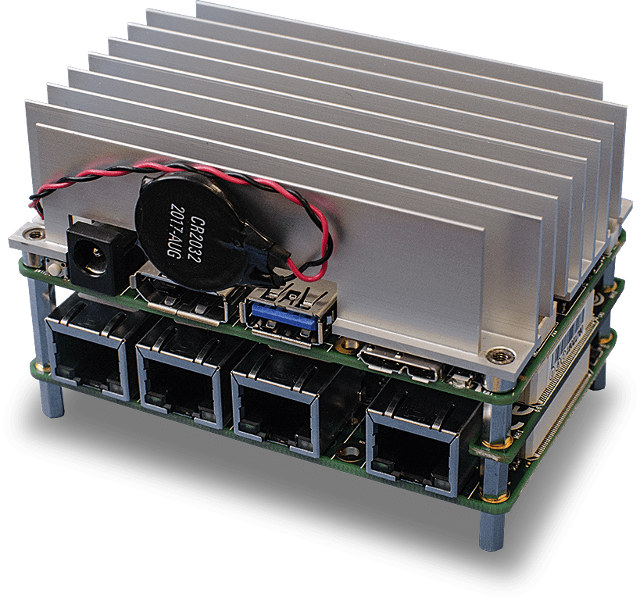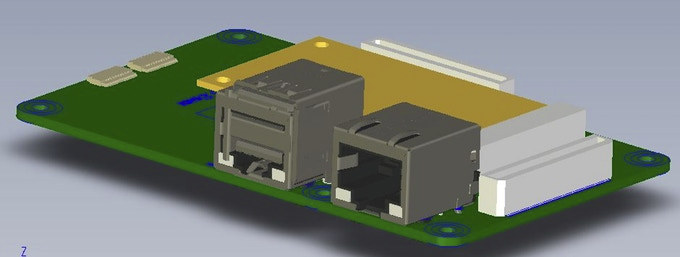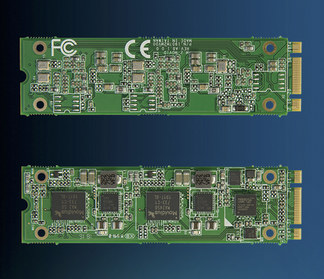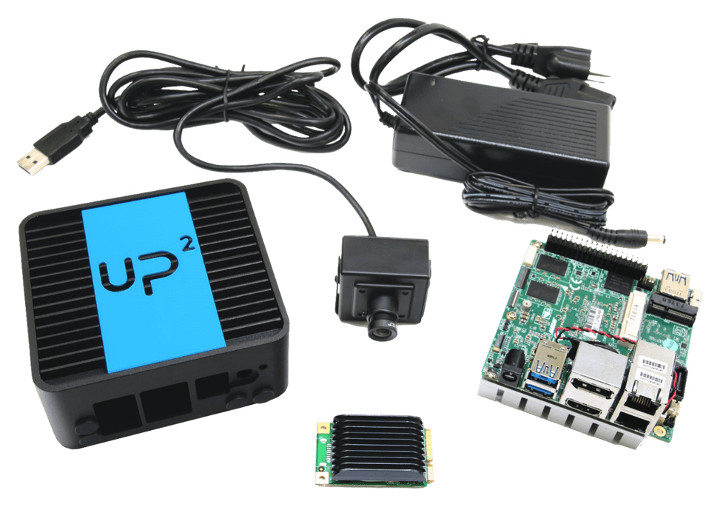Back in February of this year, AAEON introduced their UP AI Edge family of products with UP AI Core mini PCIe card based on Intel Movidius Myriad 2 VPU (Vision Processing Unit), and UP Core Plus board powered by a choice of Apollo Lake processors, and supporting AI Plus FPGA and AI Net Ethernet expansion boards.
The company has now launched a Kickstarter campaign for those boards, and added several new products including Vision Plus with three Movidius Myriad 2 VPUs, AI Core M2 with two Movidius Myriad2 VPU in M.2 2280 form factor, as well as the Up Squared AI vision development kit for OpenVINO toolkit.
I won’t go through the products announced in February, but let’s have look at the new boards and cards.
Vision Plus Board
- VPU – 3x Intel Movidius Myriad 2 VPUs with 512 MB DDR
- Connectivity – 1x Gigabit Ethernet
- USB – 2x USB 3.0 port
- Expansion – 1x mPCIEe for 3G/4G connectivity or other expansions
With three VPUs, it delivers three times the performance of a single UP AI core module.
AI Core M2 Card
This is an more powerful version of AI Core mPCIe card, and comes with two VPUs, and relies on an M.2 connector instead.
AI Core M2 specifications:
- VPU – Up to 2x Intel Movidius Myriad 2 VPUs with 512MB DDR RAM
- Form factor – M.2 2280 B+M key
UP Squared AI Vision Development Kit
While the kit is new, its content is comprised of hardware announced earlier this year including:
- UP Squared E3950 board with an Intel Atom x7-E3950 quad core Apollo Lake-I processor, 4GB RAM, and 64GB eMMC flash
- UP HD camera – A Full HD USB 2.0 camera
- AI Core mPCIe module
- A 5V/6A power supply + US or EU power cord
- VESA mountable fanless chassis
The company also provide a software package including Ubuntu 16.04.4 desktop, OpenVINO toolkit, Open CL/ Movidius Driver, Arduino Create and Intel System Studio. The kit is said to “bridge the gap between prototype and mass production and provides comprehensive cloud connectors such as Microsoft Azure, Amazon AWS, Google Cloud and IBM Bluemix”.
Kickstarter Cards, Boards and Kits

So that means we have various boards or cards that can stacked to create your own development, or complete kits to easily get started. The crowdfunding campaign has already surpassed its 10,000 Euros target, so it will go ahead in any cases, and some of rewards offered include:
- 49 Euros for AI Core M2 card with one Myriad 2 VPU
- 89 Euros for AI Core M2 card with two Myriad 2 VPUs
- 159 Euros for UCP1 UP Core Light Plus board with Intel Atom x5-E3930 CPU, 2GB RAM, 32GB eMMC, a 12V/5A power supply, and a chassis
- 319 Euros for UCPN1 AI Edge Net reward with UP Core Plus board with Intel Atom x5-E3930 CPU, 2GB RAM, 32GB eMMC, NetPlus add-on board (4x GbLAN powered by Intel i211AT), AI Core mPCIe card, UP HD Camera, a 12V/5A power supply, and a chassis.
- 349 Euros for UP Squared AI Vision Development Kit described above
- 679 Euros for UCPFV3 AI Edge-Vision+FPGA rewards with:
- UP Core Plus board with x7-E3950 CPU, 8 GB RAM, 128 GB eMMC
- AI Plus add-on board with Intel Altera Cyclone 10 220 KLE
- AI Core mPCIe card
- UP HD Camera
- 12V/5A power supply
- A chassis
I counted a total of 22 different rewards, so if you are interested in such AI solutions, you’ll likely find something that matches you need. The last rewards listed above in quite interesting as it combines an SoC with CPU + GPU, an FPGA board, and card with a vision processing unit, so you can play around and estimate which route is the best to follow for your specific application.
You also need to add shipping to the cost, which depends on the destination country and specific rewards, and delivery is planned for July to October, again depending on your selected reward(s).

Jean-Luc started CNX Software in 2010 as a part-time endeavor, before quitting his job as a software engineering manager, and starting to write daily news, and reviews full time later in 2011.
Support CNX Software! Donate via cryptocurrencies, become a Patron on Patreon, or purchase goods on Amazon or Aliexpress









From the CNXsoft Movidius writeup:
“You can enter a trained Caffe, feed-forward Convolutional Neural Network (CNN) into the toolkit, profile it, then compile a tuned version ready for embedded deployment using Intel/Movidius Neural Compute Platform API. Inference occurs in real-time in the stick itself”
PlaidML supports ONNX* you just need an OpenCL GPU to do something very similar . Many recent Mali GPUs seem have compute computing capability comparable to Myriad 2’s 100 Gglops*. I think they generally also have higher bandwdth connections to the CPU than USB3, which I guess could be a bottleneck sometimes & shared access to CPU RAM (?).
So if the GPU is the limiting factor, some existing ARM boards could also be well suited to deep learning vision processing projects.
* Open Neural Network Exchange, https://github.com/onnx/onnx
**https://gflops.surge.sh/
Standard GPU usually consume much more power to perform the same tasks that could be handled by a Myriad 2 chip.
Plus if your application is running on a dedicated VPU, your GPU is still available to run a graphical application, or any other computation needed by your platform (for example in a Intelligent Digital Signage application).
Also with the recently announced OpenVINO you will be able to distribute your CNNs into any available component on your platform (CPU, GPU, Myriad or FPGA).
Valid points; OpenVINO sounds interesting too. (Especially CNNs on FGPA. Very fast I imagine…)
My point was just that an ARM board with reasonable RAM capacity and a recent GPU could be enough for people – with requirements less strict than those above – experimenting with/prototyping DL/computer vision applications. But they might not have realised. (Because PlaidML seems to have attracted more interest in Kaggle/Deep Learning etc circles.)